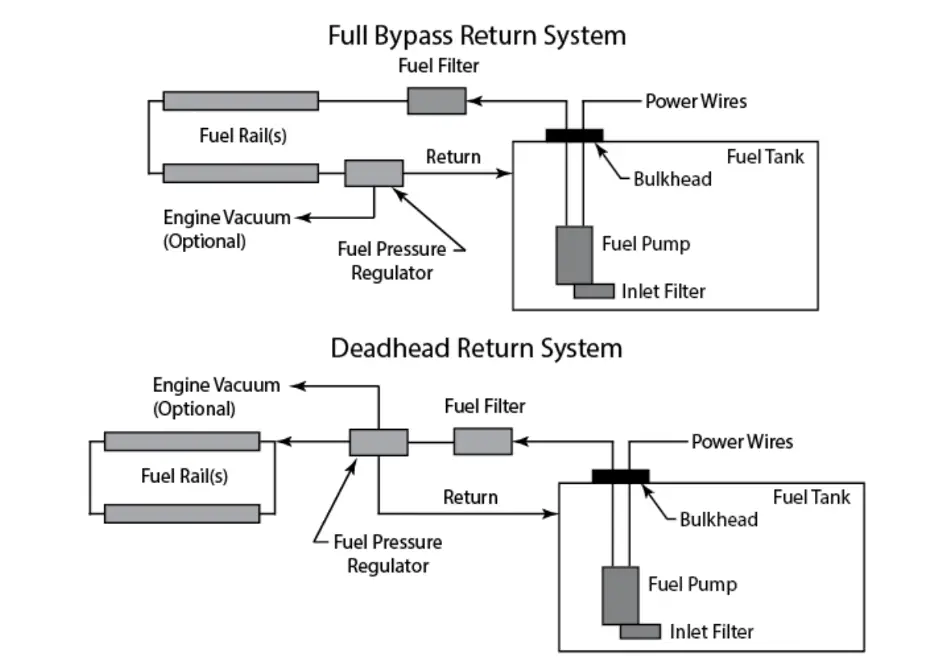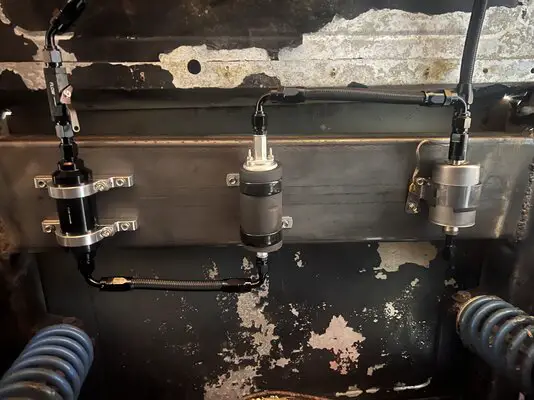That setup is a return style, will keep fuel cooler and fuel pressure more accurate as it is not dead heading, i.e. the return prevents that. Early LS from Chevrolet had a filter/regulator that returned fuel at the filter where as the one you linked will require a line from regulator all the way back to the tank. Both would be fine for a NA build but the closer the regulator is to the fuel rails the better off you are to keep heat down. Return style is almost always preferred when fuel injected.
Holley GBody Fuel System
- Thread starter T-TOP TONY
- Start date
You are using an out of date browser. It may not display this or other websites correctly.
You should upgrade or use an alternative browser.
You should upgrade or use an alternative browser.
- Status
- Not open for further replies.
Thank you brothaThat setup is a return style, will keep fuel cooler and fuel pressure more accurate as it is not dead heading, i.e. the return prevents that. Early LS from Chevrolet had a filter/regulator that returned fuel at the filter where as the one you linked will require a line from regulator all the way back to the tank. Both would be fine for a NA build but the closer the regulator is to the fuel rails the better off you are to keep heat down. Return style is almost always preferred when fuel injected.
Running EFI you want a return system. I think the pump in the kit you showed was 59.5 psi. I'll have to look again at the gallons per hour or shown as liters per minute, have to do the math conversion. You need the higher pressure to get a good spray pattern when the injector opens. Once the rail is pressurized any excess returns to the tank.
Human body is different of course, but think like this. Your muscles need blood to do work. Your heart pumps the blood, and this flows through the muscle and returns to the heart. All while the heart keeps pumping to bring more blood to the muscles to do work. This is a "closed loop" ... "full return" system.
Per a certain injector, it needs a specific pressure to operate properly. This is the same for a 4 cylinder, 6 cylinder, 8 cylinder, etc... The engine needs a specific liter per minute to make it run. Idle is a smaller amount, while wide open throttle (WOT) is much, much more.
The pump in the tank has to be capable of supplying this. So, starting, cruising, stop and go, and flat out acceleration (WOT).
With fuel injection, the easiest is to supply enough fuel at the needed pressure. All the excess returns to the tank, even though the pump keeps supplying fresh fuel to the rail.
Human body is different of course, but think like this. Your muscles need blood to do work. Your heart pumps the blood, and this flows through the muscle and returns to the heart. All while the heart keeps pumping to bring more blood to the muscles to do work. This is a "closed loop" ... "full return" system.
Per a certain injector, it needs a specific pressure to operate properly. This is the same for a 4 cylinder, 6 cylinder, 8 cylinder, etc... The engine needs a specific liter per minute to make it run. Idle is a smaller amount, while wide open throttle (WOT) is much, much more.
The pump in the tank has to be capable of supplying this. So, starting, cruising, stop and go, and flat out acceleration (WOT).
With fuel injection, the easiest is to supply enough fuel at the needed pressure. All the excess returns to the tank, even though the pump keeps supplying fresh fuel to the rail.
runs a couple of posts long, I am sure there is more to add but you will get the gistLink to what happened?
Oh man that is very unfortunate.runs a couple of posts long, I am sure there is more to add but you will get the gist
You are 100% paying for convenience there
The big thing that kit is missing is a baffled EFI tank. Having a drop in EFI sender is great but without a baffled tank you are at risk of fuel starvation in cornering or accel/braking. IMO it's like getting the bun, mustard, plate, and napkins, but not getting the hot dog.
It's 100% possible to piece the kit together for under half if you are willing to dig. It's a 'universal' kit so you might use some of the stuff and might not use other parts.
If the $350 of convenience is worth it to you, go ahead. If you are willing to learn and order some parts through multiple suppliers I'd argue you can get a better result for less money, but it's going to take time.
The big thing that kit is missing is a baffled EFI tank. Having a drop in EFI sender is great but without a baffled tank you are at risk of fuel starvation in cornering or accel/braking. IMO it's like getting the bun, mustard, plate, and napkins, but not getting the hot dog.
It's 100% possible to piece the kit together for under half if you are willing to dig. It's a 'universal' kit so you might use some of the stuff and might not use other parts.
If the $350 of convenience is worth it to you, go ahead. If you are willing to learn and order some parts through multiple suppliers I'd argue you can get a better result for less money, but it's going to take time.
Not a bad price for one such tank, (but Holley doesn't say it's baffled) - https://www.holley.com/products/fue...tUl9QsamEfAZkYw86k1z6FKewSETltjxoCIsAQAvD_BwEYou are 100% paying for convenience there
The big thing that kit is missing is a baffled EFI tank. Having a drop in EFI sender is great but without a baffled tank you are at risk of fuel starvation in cornering or accel/braking. IMO it's like getting the bun, mustard, plate, and napkins, but not getting the hot dog...
Early LS was on the Rails.. 😉 1997-98 Corvette, 1998 LS Fbody, and GMT800 Trucks up until 2003 were all Vacuum Regulated on the Fuel Rails. Two Lines on them Rails. 3/8" feed, 5/16" return.That setup is a return style, will keep fuel cooler and fuel pressure more accurate as it is not dead heading, i.e. the return prevents that. Early LS from Chevrolet had a filter/regulator that returned fuel at the filter where as the one you linked will require a line from regulator all the way back to the tank. Both would be fine for a NA build but the closer the regulator is to the fuel rails the better off you are to keep heat down. Return style is almost always preferred when fuel injected.
Next is what you mention. 1999-up Corvette got the Regulator/Filter mounted close to the Gas Tank, 99-02 Fbody had the Regulator on the Sending Unit, same with the 03-up Trucks and everything else you'll see. 99-04 Corvette and 99-02 Fbody have a dampener on the Rails that looks like the Regulator, but it's not the same. 2004 GTO was the same with the LS1, 2004 LS6 CTSV as well and anything else in that year that was RPO Code LS Engine. Gen III LS is my stuff. 🙂
Once Flex Fuel came out it's all PWM controlled Pumps, computer controlled pressure. Pretty much all are that now.
Single line in on my SS here, with that dampened single inlet Rail..

Same Rail on my 2002 C5 Z06, all factory here..

Ideal is to have the Regulator as close to the Rails, as mentioned. In my SS I have it on the lower front of the Frame Rail with a single feed line going to the Rails. System makes a nice loop from and back to the tank.

Last edited:
You would think it’s actually the opposite, returnless style tends to keep the fuel cooler since it’s not circulating fuel that’s been through the hot engine bay back to the tank, which that point is defeated in your setup since it’s going to the engine bay directly next to the header and then returned
The other point is fuel pressure regulator mounting location, mounting closer to the engine will give you less pulsing frequencies in the fuel line, but ideally you would want the return path as short as possible, hence why I mounted mine directly under the tank
The other point is fuel pressure regulator mounting location, mounting closer to the engine will give you less pulsing frequencies in the fuel line, but ideally you would want the return path as short as possible, hence why I mounted mine directly under the tank
Attachments
Last edited:
- Status
- Not open for further replies.
Similar threads
- Replies
- 3
- Views
- 81
- Replies
- 3
- Views
- 89
- Replies
- 8
- Views
- 154
GBodyForum is a participant in the Amazon Services LLC Associates Program, an affiliate advertising program designed to provide a means for sites to earn advertising fees by advertising and linking to amazon.com. Amazon, the Amazon logo, AmazonSupply, and the AmazonSupply logo are trademarks of Amazon.com, Inc. or its affiliates.



